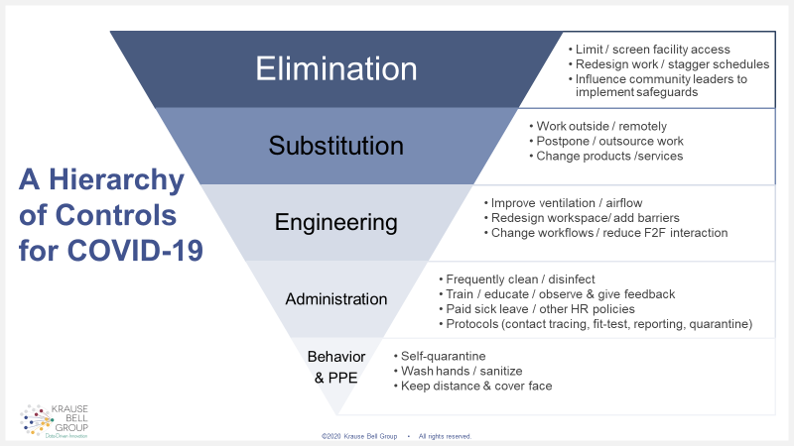August 13, 2020
The Roles of Decision Making and Behavior in Ending the COVID-19 Pandemic
When the COVID-19 pandemic started, organizations scrambled to understand the risks and develop comprehensive prevention strategies. Today, most organizations have implemented safeguards at every level of the hierarchy of controls. No matter how good a job management has done to eliminate, substitute, engineer and administer away the hazards, we remain dependent on leadership decision making and human behavior to prevent transmission of the virus.
Critical behaviors like handwashing, maintaining physical distance, using a mask, and self-quarantining require high levels of behavioral reliability in order to be effective. We know that leadership decisions directly influence these critical behaviors. In the graphic below, note that the top four controls are all about leaders making decisions. These decisions, in turn, create the context for the behavioral safeguards at the bottom of the hierarchy.

Behavioral Reliability Isn’t Easy
All kinds of barriers exist making it difficult to achieve behavioral reliability. Ambiguity around the right behaviors almost guarantees behavior will vary: Are face coverings helpful or harmful? Experts disagreed early on and shortages of the most effective face masks complicated the answer. New research continues to emerge. Moreover, any behavior can have competing consequences that reduce reliability. For example, physical distance creates emotional distance, coldness, and a feeling of being antisocial. Doing the right thing from a disease standpoint comes with a hefty social & emotional toll, which means there will be variation.
A Powerful Tool
Despite all this, there are better and worse strategies for implementing the behavioral safeguards. Knowledge and experience exist for doing this well. Behavioral science has applicable knowledge and at Krause Bell Group, we have decades of experience applying this knowledge in a wide variety of dynamic organizations. ABC analysis is a particularly helpful tool when used responsibly. We moved away from it at Krause Bell Group because too many people think it is about “fixing” the employee. When used properly, it leads to an understanding of the context in which behavior exists. Astute leaders can then improve decisions and strengthen safeguards at every level of the hierarchy of controls.
Click here for an example of ABC analysis.
ABC analysis applies to a wide range of situations. Getting someone to wear a mask in an empty office, while entirely possible, is of limited value. But how about getting everyone to follow your organization’s face covering policy? ABC analysis becomes immensely more powerful when it is applied to strategically important behaviors and when the analysis itself is informed by real information from people’s personal experience. Moreover, when senior leader decisions, behaviors, and messages are added into the mix of available antecedents and consequences, there is no reason that behavioral reliability can’t be achieved.
What Leaders Can Do
Whether sitting at the local, regional, or company-wide levels of your organization, leaders who want to develop and sustain high levels of reliability around the COVID-19 safeguards need to:
- Start with the organization’s COVID-19 safeguards and identify the critical few behaviors that must be at a high level of reliability in order to prevent disease introduction and transmission into your workplace. Consider this a strategically important decision, one that deserves your very best decision hygiene.
- Develop your data: For each COVID-19 critical behavior, select several locations and do a series of ABC analyses. Aggregate the results and look for trends, common barriers, and where senior leaders “touch it.”
- Pinpoint where senior leader decisions, behaviors, questions and messages can create the ideal context for the COVID-19 critical behaviors.
- Using the findings to create individual and organization-wide improvement plans.
Further Reading
Dr. Tom Krause writes about the relationship between decisions and behavior in this article.
Get more insight from Dr. Krause and Kristen Bell in their 2015 book, 7 Insights into Safety Leadership.
The Roles of Decision Making and Behavior in Ending the COVID-19 Pandemic
August 13, 2020
By Tom Krause & Kristen BellShare this post:
Search for articles


